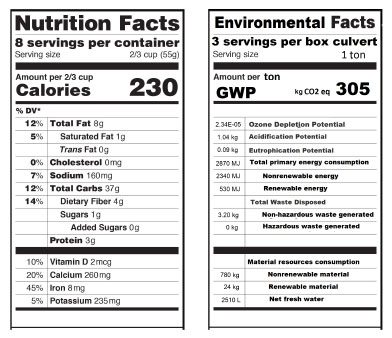PRODUCER RESOURCES
Environmental Product DeclarationsAs more state and federal agencies and local municipalities institute Environmental Product Declaration (EPD) requirements for precast concrete products, precasters need to understand what an EPD is, how it’s used and the process for securing these documents.
What You Need to Know
Growing concerns about sustainability and the impact of construction materials on the environment have prompted government entities to implement carbon-related standards. These new standards often require contractors to provide EPDs for the products used in projects. Because precast concrete is essential to the nation’s infrastructure, it’s critical that the industry is prepared to meet the requirements.

What is an EPD?
An Environmental Product Declaration (EPD) is an independently verified document that discloses the life cycle of a product and its impact on the environment, including global warming potential, smog creations, ozone depletion and water pollution.
EPDs are often compared to nutrition labels for food, relaying the vital facts needed to evaluate the potential impact of using the product.
EPDs for precasters are “cradle to gate,” encompassing the product’s life-cycle from raw material extraction to transport to the facility to manufacturing. The data report stops when the product leaves the facility’s gate.
Know the Difference in the Three Types of EPDs
Industrywide: Based on aggregated information provided by producers.
Facility-specific: Based on data from every product manufactured in one plant or group of plants owned by the same company in one geographic location.
Product-specific: Based solely on data from a product’s materials and manufacturing.
While industrywide EPDs have been applicable for precast in the past, jurisdictions are now requiring a Type III plant-specific or product-specific EPD, meaning separate documents for your box culverts, manholes, retaining walls and any other product you manufacture.

Focus of EPDs is on Carbon Emissions
Carbon dioxide (CO2) is the primary greenhouse gas that traps heat in the atmosphere. While CO2 is naturally present, human activities, including industrial processes, continue to add a considerable amount.
In an effort to curb the amount of human-generated greenhouse gases (GHGs) entering the atmosphere, governments are utilizing one of the elements included in an EPD, a product’s Global Warming Potential (GWP), to evaluate its impact. GWP is a measure of how much energy the emissions of 1 ton of a gas will absorb over a given time relative to the emissions of 1 ton of CO2. The larger a product’s GWP, the more that gas affects the Earth’s temperature compared to CO2.
Why Does It Matter?
Strength, durability and cost remain important factors in specifier selection criteria, but GWP is quickly rising to the top as government entities at all levels implement carbon-related standards.
Examples of Recent EPD Requirements
- As of July 1, the Colorado Department of Transportation is requiring GWP data in the form of type III product-specific EPDs.
- In March 2022, the U.S. General Services Administration issued a memorandum announcing the implementation of new national standards for low embodied carbon concrete and environmentally preferable asphalt. These standards require product-specific cradle-to-gate Type III EPDs.
- The 2020 Strategic Climate Action Plan for King County, Wash., commits to specifying low-carbon materials in capital projects and specifically mentions concrete. The county began requiring EPDs this year and will set a maximum GWP by 2024.
Explore the State EPD Standards map to see if your state requires EPDs.
How Does the Process Work?
The first step is to conduct a life cycle assessment (LCA) of your facility’s processes and products. An LCA is a study of the impacts of all the products made at the plant. Impacts are based on:
- Raw materials data.
- Production processes.
- Energy use.
- Waste generation.
Manufacturers must submit 12 months of data to a third-party LCA practitioner. This data is then converted into impacts in many categories.
LCAs are written according to certain parameters and conditions laid out in a product category rule (PCR). A PCR addresses specific products and is created and maintained by a committee.
An EPD, which is a summary of the LCA, will be generated by a third-party software based on the LCA results. It must be verified by another third party. ASTM is one approved verifier.
At this point, the EPD can be submitted to a jurisdiction and is good for five years.
How Long Does the Process Take?
The bulk of the work falls on the precaster, who must collect all the initial data. Then, from the time data is submitted to the third-party to getting a verified EPD to submit to a jurisdiction, the process can take two to three months. Subsequent EPDs are typically returned much faster, within two to three weeks.
Benchmarks vs. Limits
Some jurisdictions are simply seeking disclosures and setting benchmarks. All that’s required is for an EPD to be submitted.
Others are requesting EPDs and setting GWP limits that must be met to be considered for the project.
How Can NPCA Help?
NPCA can provide you with the resources to begin the EPD process:



